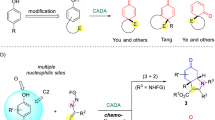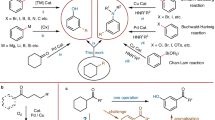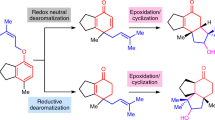Abstract
Phenols and their derivatives are ubiquitous in nature and critically important industrial chemicals. Their properties are intimately linked to the relative substitution pattern of the aromatic ring, reflecting well-known electronic effects of the OH group. Because of these ortho-, para-directing effects, meta-substituted phenols have historically been more difficult to synthesize. Here we describe a procedure to transpose phenols that hinges on a regioselective diazotization of the corresponding ortho-quinone. The procedure affords the meta-substituted phenol directly from its more common and accessible para-substituted isomer, and demonstrates good chemoselectivity that enables its application in late-stage settings. By changing the electronic effect of the OH group and its trajectory of hydrogen bonding, our transposition can be used to diversify natural products and existing chemical libraries, and potentially shorten the length and cost of producing underrepresented arene isomers.

This is a preview of subscription content, access via your institution
Access options
Access Nature and 54 other Nature Portfolio journals
Get Nature+, our best-value online-access subscription
$29.99 / 30 days
cancel any time
Subscribe to this journal
Receive 12 print issues and online access
$259.00 per year
only $21.58 per issue
Buy this article
- Purchase on Springer Link
- Instant access to full article PDF
Prices may be subject to local taxes which are calculated during checkout



Similar content being viewed by others
Data availability
The data supporting the main findings of this study are available in the article, Supplementary Information and source data. Source data, including unprocessed free induction decays (FIDs) of all compounds, are available for download, free of charge, from the Open Science Framework (OSF) data repository at https://osf.io/e7q8n (ref. 50).
References
Tyman, J. H. Synthetic and Natural Phenols (Elsevier, 1996).
Huang, Z. & Lumb, J.-P. Phenol-directed C–H functionalization. ACS Catal. 9, 521–555 (2019).
Hesse, W. & Lang, J. Phenolic resins. Ullmann’s Encycl. Ind. Chem. 26, 583–600 (2011).
Scott, K. A., Cox, P. B. & Njardarson, J. T. Phenols in pharmaceuticals: analysis of a recurring motif. J. Med. Chem. 65, 7044–7072 (2022).
Foti, M. C. Antioxidant properties of phenols. J. Pharm. Pharmacol. 59, 1673–1685 (2010).
Burley, S. K. & Petsko, G. A. Aromatic–aromatic interaction: a mechanism of protein structure stabilization. Science 229, 23–28 (1985).
Manglik, A. et al. Crystal structure of the µ-opioid receptor bound to a morphinan antagonist. Nature 485, 321–326 (2012).
Qiu, Z. & Li, C.-J. Transformations of less-activated phenols and phenol derivatives via C–O cleavage. Chem. Rev. 120, 10454–10515 (2020).
Quideau, S., Deffieux, D. & Pouységu, L. in Comprehensive Organic Synthesis (Second Edition) (ed. Knochel, P.) 656–740 (Elsevier, 2014).
Pouységu, L., Deffieux, D. & Quideau, S. Hypervalent iodine-mediated phenol dearomatization in natural product synthesis. Tetrahedron 66, 2235–2261 (2010).
Gross, K. C. & Seybold, P. G. Substituent effects on the physical properties and pKa of phenol. Int. J. Quantum Chem. 85, 569–579 (2001).
Bertin, C. et al. Grass roots chemistry: meta-tyrosine, an herbicidal nonprotein amino acid. Proc. Natl Acad. Sci. USA 104, 16964–16969 (2007).
Tyminski, M., Ciacka, K., Staszek, P., Gniazdowska, A. & Krasuska, U. Toxicity of meta-tyrosine. Plants 10, 2800 (2021).
Izawa, Y., Pun, D. & Stahl, S. S. Palladium-catalyzed aerobic dehydrogenation of substituted cyclohexanones to phenols. Science 333, 209–213 (2011).
Izawa, Y., Zheng, C. & Stahl, S. S. Aerobic oxidative Heck/dehydrogenation reactions of cyclohexenones: efficient access to meta-substituted phenols. Angew. Chem. Int. Ed. 52, 3672–3675 (2013).
Fier, P. S. & Maloney, K. M. Synthesis of complex phenols enabled by a rationally designed hydroxide surrogate. Angew. Chem. Int. Ed. 56, 4478–4482 (2017).
Xu, J. et al. Highly efficient synthesis of phenols by copper-catalyzed oxidative hydroxylation of arylboronic acids at room temperature in water. Org. Lett. 12, 1964–1967 (2010).
Maleczka, R. E., Shi, F., Holmes, D. & Smith, M. R. C–H activation/borylation/oxidation: a one-pot unified route to meta-substituted phenols bearing ortho-/para-directing groups. J. Am. Chem. Soc. 125, 7792–7793 (2003).
Senior, A., Ruffell, K. & Ball, L. T. meta-Selective C–H arylation of phenols via regiodiversion of electrophilic aromatic substitution. Nat. Chem. 15, 386–394 (2023).
Li, Z. et al. A tautomeric ligand enables directed C–H hydroxylation with molecular oxygen. Science 372, 1452–1457 (2021).
Yuan, C. et al. Metal-free oxidation of aromatic carbon–hydrogen bonds through a reverse-rebound mechanism. Nature 499, 192–196 (2013).
Sang, R. et al. Site‐selective C–H oxygenation via aryl sulfonium salts. Angew. Chem. Int. Ed. 58, 16161–16166 (2019).
Nilova, A., Campeau, L.-C., Sherer, E. C. & Stuart, D. R. Analysis of benzenoid substitution patterns in small molecule active pharmaceutical ingredients. J. Med. Chem. 63, 13389–13396 (2020).
Schnürch, M., Spina, M., Khan, A. F., Mihovilovic, M. D. & Stanetty, P. Halogen dance reactions—a review. Chem. Soc. Rev. 36, 1046–1057 (2007).
Matsushita, K., Takise, R., Muto, K. & Yamaguchi, J. Ester dance reaction on the aromatic ring. Sci. Adv. 6, eaba7614 (2020).
Nakahara, H. & Yamaguchi, J. Aryl dance reaction of arylbenzoheteroles. Org. Lett. 24, 8083–8087 (2022).
Bolton, A., Lanewala, M. & Pickert, P. Isomerization of tert-butylphenols using zeolite catalysts. J. Org. Chem. 33, 3415–3418 (1968).
Jacquesy, J.-C. & Jouannetaud, M.-P. Mechanism of isomerization of ortho or para bromo phenols in superacids. Tetrahedron Lett. 23, 1673–1676 (1982).
Cernak, T., Dykstra, K. D., Tyagarajan, S., Vachal, P. & Krska, S. W. The medicinal chemist’s toolbox for late stage functionalization of drug-like molecules. Chem. Soc. Rev. 45, 546–576 (2016).
Esguerra, K. V. N., Xu, W. & Lumb, J.-P. Unified synthesis of 1,2-oxy-aminoarenes via a bio-inspired phenol–amine coupling. Chem 2, 533–549 (2017).
Esguerra, K. V. N. & Lumb, J.-P. A bioinspired catalytic aerobic functionalization of phenols: regioselective construction of aromatic C–N and C–O bonds. ACS Catal. 7, 3477–3482 (2017).
Esguerra, K. V. N. & Lumb, J.-P. Synthesis of ortho-azophenols by formal dehydrogenative coupling of phenols and hydrazines or hydrazides. Eur. J. Chem. 23, 8596–8600 (2017).
Esguerra, K. V. N., Fall, Y. & Lumb, J.-P. A biomimetic catalytic aerobic functionalization of phenols. Angew. Chem. Int. Ed. 53, 5877–5881 (2014).
Magdziak, D., Rodriguez, A. A., Van De Water, R. W. & Pettus, T. R. R. Regioselective oxidation of phenols to o-quinones with o-iodoxybenzoic acid (IBX). Org. Lett. 4, 285–288 (2002).
Cava, M. P., Litle, R. L. & Napier, D. R. Condensed cyclobutane aromatic systems. V. The synthesis of some α-diazoindanones: ring contraction in the indane series. J. Am. Chem. Soc. 80, 2257–2263 (1958).
Nematollahi, D., Rahchamani, R. & Malekzadeh, M. Electrochemical sulfonylation of 4-tert-butylcatechol. Synth. Commun. 33, 2269–2274 (2003).
Kornblum, N., Cooper, G. D. & Taylor, J. E. The chemistry of diazo compounds. II. Evidence for a free radical chain mechanism in the reduction of diazonium salts by hypophosphorous acid. J. Am. Chem. Soc. 72, 3013–3021 (1950).
Clews, J. et al. Novel heterocyclic betaines relevant to the mechanism of tyrosinase-catalysed oxidation of phenols. Chem. Commun. 77–78 (1998).
Clews, J. et al. Oxidative cyclisation of N,N-dialkylcatechol amines to heterocyclic betaines via o-quinones: synthetic, pulse radiolytic and enzyme studies. J. Chem. Soc. Perkin Trans. 1. 4306–4315 (2000).
Huang, Z. et al. A bio-inspired synthesis of oxindoles by catalytic aerobic dual C–H functionalization of phenols. Chem. Sci. 7, 358–369 (2016).
Kosoglou, T. et al. Ezetimibe: a review of its metabolism, pharmacokinetics and drug interactions. Clin. Pharmacokinet. 44, 467–494 (2005).
Mravljak, J., Sova, M., Ko-Vac, A., Gobec, S. & Casar, Z. Process for the synthesis of ezetimibe and intermediates useful therefor. Slovenia patent (2010).
Klingler, F. D. in Asymmetric Catalysis on Industrial Scale (eds Blaser, H. U., Federsel, H. J.) 171–185 (Wiley‐VCH, 2010).
Stewart, I., Newhall, W. F. & Edwards, G. J. The isolation and identification of l-synephrine in the leaves and fruit of citrus. J. Biol. Chem. 239, 930–932 (1964).
Lu, T.-M., Ko, H.-H., Ng, L.-T. & Hsieh, Y.-P. Free-radical-scavenging, antityrosinase, and cellular melanogenesis inhibitory activities of synthetic isoflavones. Chem. Biodivers. 12, 963–979 (2015).
Zhang, Q., Tu, T., D’Avignon, D. A. & Gross, M. L. Balance of beneficial and deleterious health effects of quinones: a case study of the chemical properties of genistein and estrone quinones. J. Am. Chem. Soc. 131, 1067–1076 (2009).
Ross, A. J., Lang, H. L. & Jackson, R. F. W. Much improved conditions for the Negishi cross-coupling of iodoalanine derived zinc reagents with aryl halides. J. Org. Chem. 75, 245–248 (2010).
Esguerra, K. V. N. & Lumb, J.-P. Selectivity in the aerobic dearomatization of phenols: total synthesis of dehydronornuciferine by chemo- and regioselective oxidation. Angew. Chem. Int. Ed. 57, 1514–1518 (2018).
Marmelstein, A. M. et al. Tyrosinase-mediated oxidative coupling of tyrosine tags on peptides and proteins. J. Am. Chem. Soc. 142, 5078–5086 (2020).
Lumb, J.-P. Open Science Framework Data Repository, OSF, https://osf.io/e7q8n (2024).
Acknowledgements
We thank I. Mbaezue (McGill University) for help with high-performance liquid chromatography, and K. Levin (McGill University) for help with NMR. Financial support was provided by the Natural Sciences and Engineering Research Council of Canada (NSERC Discovery Grant to J.-P.L). S.E. acknowledges NSERC (CGS-M) and the Fonds de Recherche du Québec Nature et Technologies (FRQNT-B1X and FRQNT-B2X) for research fellowships, the Walter C. Sumner Foundation for a Memorial Fellowship and McGill University for financial support.
Author information
Authors and Affiliations
Contributions
S.E. designed and conducted experiments, and collected and analysed the data. J.-P.L. and S.E. conceptualized the project and wrote the manuscript. J.-P.L. supervised the research.
Corresponding author
Ethics declarations
Competing interests
The authors declare no competing interests.
Peer review
Peer review information
Nature Chemistry thanks Junichiro Yamaguchi, Derrick Clive and Ning Jiao for their contribution to the peer review of this work.
Additional information
Publisher’s note Springer Nature remains neutral with regard to jurisdictional claims in published maps and institutional affiliations.
Supplementary information
Supplementary Information
Supplementary Figs. 1–3, discussion of procedures, and processed characterization data including tabulated infra-red and mass spectrometry, along with 1H- and 13C-NMR data, in both tabulated and graphical forms.
Supplementary Data
Unprocessed FIDs for all NMR characterization data, designated by compound numbers as they appear in the text of the paper or in Supplementary Information.
Rights and permissions
Springer Nature or its licensor (e.g. a society or other partner) holds exclusive rights to this article under a publishing agreement with the author(s) or other rightsholder(s); author self-archiving of the accepted manuscript version of this article is solely governed by the terms of such publishing agreement and applicable law.
About this article
Cite this article
Edelmann, S., Lumb, JP. A para- to meta-isomerization of phenols. Nat. Chem. (2024). https://doi.org/10.1038/s41557-024-01512-1
Received:
Accepted:
Published:
DOI: https://doi.org/10.1038/s41557-024-01512-1



